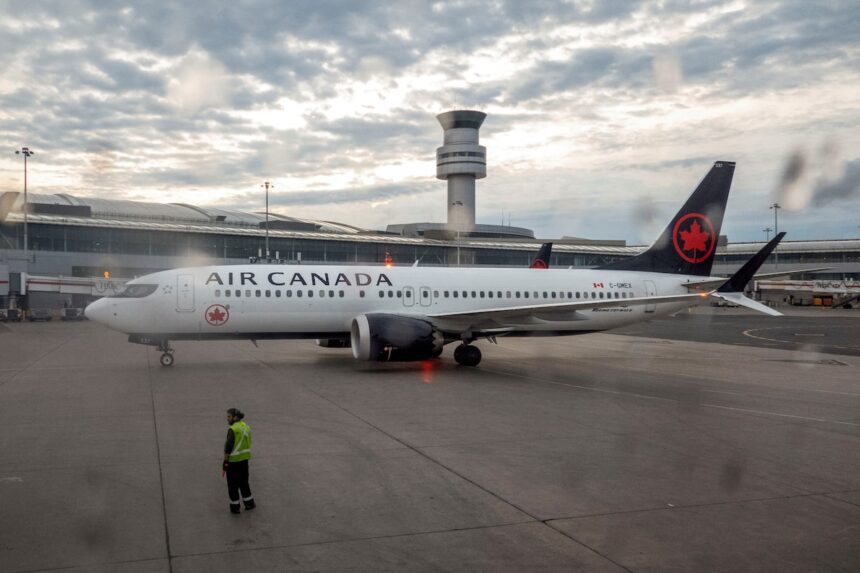Air Canada just wrapped up their second-quarter financial report, and it’s clear the turbulence in their U.S. travel segment has created some financial headwinds. The country’s largest airline posted a profit of $301 million for the quarter ending June 30, which marks a concerning 31% decline from the $437 million they earned during the same period last year.
What’s behind this notable drop? Michael Rousseau, Air Canada’s President and CEO, pointed directly to “softness in the U.S. leisure market” during the company’s earnings call yesterday morning. This weakness caught many industry analysts by surprise, especially considering how the airline had previously emphasized its strategic focus on U.S. routes.
“We’re seeing a significant recalibration of leisure travel demand, particularly for cross-border trips,” Rousseau explained. “Canadian travelers appear to be more selective about their U.S. destinations, likely influenced by the combined pressure of exchange rates and general economic uncertainty.”
The numbers tell a revealing story. While overall passenger revenue increased modestly by 2.4% to $4.97 billion, the airline’s yield—a critical metric measuring average fare per passenger per kilometer—decreased by 3.9%. This suggests Air Canada has been forced to offer more competitive pricing to fill seats, squeezing their profit margins in the process.
When compared to its major North American competitors, Air Canada’s performance raises some eyebrows. Delta Air Lines recently reported a 19% increase in quarterly profit, while United Airlines saw earnings jump by 27% for the same period. This divergence highlights the unique challenges facing Canada’s flagship carrier.
Industry analyst Cameron Doerksen of National Bank Financial noted that the results “definitely underperformed market expectations,” pointing out that most forecasts had anticipated a much smaller profit decline. “The U.S. leisure market weakness appears more structural than cyclical, which raises questions about Air Canada’s medium-term revenue strategy,” Doerksen added.
Beyond the U.S. travel softness, Air Canada also faced rising operational costs. Operating expenses increased by 5.1% to $4.76 billion, with aircraft maintenance costs jumping a significant 15% compared to the previous year. The airline attributed this partly to aging aircraft and inflation in parts and labor.
Fuel continues to represent a major expense, with costs rising 4.3% despite only a modest increase in capacity. The airline’s adjusted cost per available seat mile (CASM)—a key efficiency metric—increased by 2.7%, suggesting challenges in maintaining operational efficiency despite technological investments.
However, it wasn’t all turbulence for the Montreal-based carrier. Air Canada’s international routes, particularly those to Europe and Asia, showed resilience with passenger revenues increasing by 6.1% and 8.7% respectively. The airline’s loyalty program, Aeroplan, also continued its strong performance with a 12% increase in gross billings.
Rousseau highlighted these bright spots during the earnings call: “Our diversification strategy is paying dividends, particularly in our international markets where demand remains robust. We’re seeing especially strong performance in our Asia-Pacific routes as travel to and from that region continues to normalize post-pandemic.”
The airline is responding to these challenges with several strategic adjustments. Air Canada announced it would be “optimizing” its fall and winter schedule, which industry observers interpret as reducing capacity on underperforming U.S. routes. Additionally, the airline plans to accelerate the retirement of some older, less fuel-efficient aircraft to improve overall fleet economics.
For Canadian travelers, these adjustments might mean fewer flight options to certain U.S. destinations, though Air Canada executives were quick to emphasize they remain committed to serving major American markets. The airline is also increasing its focus on domestic routes, where demand has remained relatively stable.
Financial markets reacted to the news with predictable caution. Air Canada’s shares dropped nearly 5% following the earnings announcement, with trading volume significantly above average. The stock has now declined approximately 12% year-to-date, underperforming both the broader TSX Composite Index and the S&P 500 Airlines Index.
Looking ahead, Air Canada maintained its full-year guidance but acknowledged increased “headwinds and uncertainty” in the North American travel market. The airline projects an adjusted EBITDA (earnings before interest, taxes, depreciation, and amortization) of $3.7-4.2 billion for 2024, unchanged from previous forecasts.
For everyday Canadians, these results might signal a silver lining: continued competitive pricing on U.S. routes as Air Canada and other carriers battle for market share. However, the airline’s capacity adjustments could mean fewer seat options on certain routes as we head into the fall and winter seasons.
The airline industry’s recovery from the pandemic has been anything but smooth, and Air Canada’s latest results show that even as overall travel volumes approach pre-pandemic levels, the composition and economics of that travel continue to evolve in sometimes unpredictable ways.
As one Toronto-based travel analyst put it, “Air Canada is navigating a complex new normal where travelers have different priorities and spending patterns. The challenge isn’t just getting back to pre-pandemic numbers, but adapting to fundamentally altered consumer behavior.”
Whether Air Canada can successfully adjust to these shifting winds remains to be seen, but one thing is certain: the journey ahead promises continued turbulence for Canada’s largest airline.






